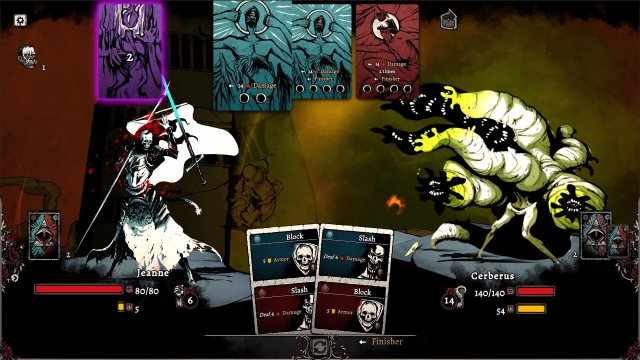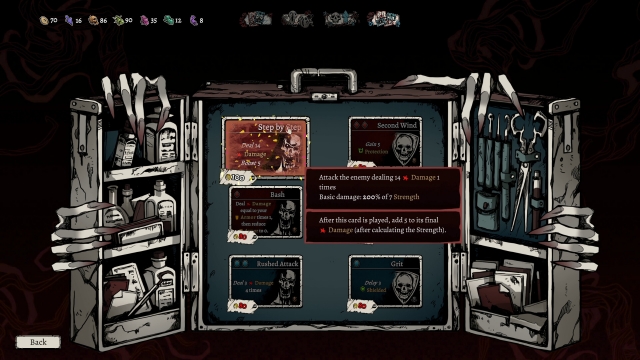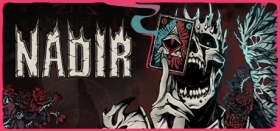
Nadir: A Grimdark Deckbuilder Review
We’ve been playing card games for centuries, and there are so many different types of card games. But the one we’re talking about today is a deck-building videogame called Nadir: A Grimdark Deckbuilder, which is a unique spin on the genre as it has turned-based combat and a unique art style. So what’s the deal with this title? How approachable is it for newcomers, and most importantly, how did the developers handle yet another PC to Nintendo Switch port? Let’s find out!
Nadir: A Grimdark Deckbuilder is a roguelike deck-building card game where you play as a demon who has been banished to Hell, and your only chance for survival is to build the best deck possible while continuously crafting different cards and, at the same time, trading some of those cards in to gather even stronger cards. Seems cool, right? That’s because it is! One of my favourite parts about this whole process is how accessible it is. Many RPGs and titles in this genre seem to struggle with simplicity, as there is usually a convoluted combat system, overly-complicated plot, or unreasonably hard-to-read dialogue text. For Nadir, though, the tutorial is quick, with only a few text boxes you need to read to understand the basics before you’re thrown into a tutorial battle because the best way to teach someone how to do something is to make them do it. Plus, the cards are in only two colours: red and blue. That’s great because when you’re in the heat of the battle, there is almost no way to confuse the two except for some missed opportunities.
The cards' abilities, similar to the common actions for damaging or defending, are here known as decay and rot. Both the cards' abilities, similar to the common actions for damaging or defending, are here known as decay and rot do different things to your enemy, such as rotting the shield meter down and suffering extra damage every time it’s hit. Another aspect of combat is the number of attacks one card can do, as some will make an attack once, and some will make multiple attacks. You’ll want to consider all this before unleashing a crushing blow on an unsuspecting demon. This stuff might sound complicated, but trust me, once you get the basics down, it doesn’t take long until you’re throwing cards out like nothing, and this is one of my favourite parts of the game.

However, some opportunities could be improved here. One of which is the text, which can be near unreadable most of the time and when you’re trying to dish out a crucial attack, squinting so much that it causes you to have a headache can be very frustrating. It’s also disappointing to see how the arrow that shows the player their cards covers those cards for almost no reason. Developers seem to struggle with converting a PC game to a console version, and the problems don’t stop there. The crafting and city building modes feel unfinished, and weirdly convoluted. Why is the crafting so complicated? Why can’t I see what the cards will do once crafted?
I get Black Eye Games wanted to immerse the player in the world, but it would’ve been better off just creating a standard crafting system because the one it has now feels unfinished. Once I combined the two cards' abilities, I had no idea what I had accomplished due to the lack of a pop-up screen. This really sucks because if they were the only issue, I would have an easier time looking past it, but unfortunately, it’s not. I had a similar experience with the base-building aspect of Nadir, too. Now, I understand the team wanted to add some variety to their project but building up your home base didn’t seem to add much to the overall experience because, with this being a roguelite, each run will be different. So if Shockwave Games wanted to create a sense of place in this game, then why didn’t it make a more prominent story if it wanted to develop an understanding of mystery in every run, then why even have the other modes at all? It’s kind of all over the place, you know?
At least the combat is fun, though. Forgetting the strange design decisions for a moment, there is something satisfying about staying back and shielding for a while and then going all out with attack after attack, annihilating your foe in one fell swoop. Every card has a limited amount of uses, and you’ll want to consider how much shield you have left and whether you can afford to attack. There is a sense of push and pull during combat which is heightened during the more difficult battles; it’s great. The visuals are fantastic, too, and honestly, I haven’t seen anything like them before. It’s refreshing to see something unique for a change, and the soundtrack is also good, even though it’s just ambient noise. I also love how the art style doesn’t get in the way of what’s most important. There are lots of black outlines on what’s in the foreground, further enhancing that sense of clarity. The text and puzzling arrow placement still get in the way, though. This game is a bit of an enigma.

Nadir: A Grimdark Deckbuilder is a strange game. It has a great art style and a fun combat system, but its crafting and base-building systems feel unfinished, and it often feels like it’s all over the place in terms of what it is trying to accomplish. I wanted to love this title, and at times, I did, especially when its combat system clicked for me, but I’d suggest playing it on PC or just playing something else like Slay the Spire, honestly.
Nadir: A Grimdark Deckbuilder (Reviewed on Nintendo Switch)
Game is enjoyable, outweighing the issues there may be.
Nadir: A Grimdark Deckbuilder seems like the developers wanted to make a roguelike and then decided to make a story-focused game halfway through without ever following through on that desire. If Black Eye Games had fixed some of this game’s glaring issues, we could’ve had something cool here, but there are still much better options out there.








COMMENTS